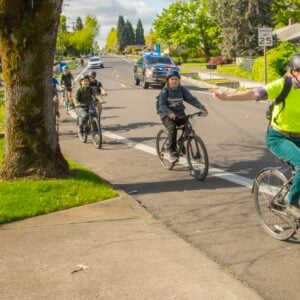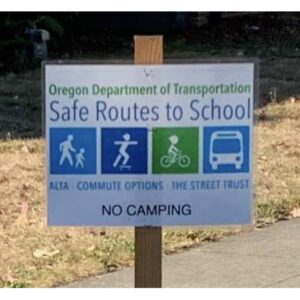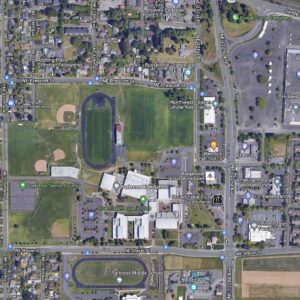“Our hope is to find funding to backfill the Safe Routes program…but we can’t guarantee that.”
— Catherine Ciarlo, transportation policy advisor for Mayor Adams
Mayor Adams made his first State of the City address at the City Club in downtown Portland today.
According to a report just published by the Portland Tribune, he apologized for the distraction of the Beau Breedlove situation and he outlined his efforts to make Portland a sustainability leader. The Trib writes that Adams was “warmly received” and that he received a partial standing ovation and hearty applause from the crowd (more coverage of the event here).
The Portland Mercury reports that he was questioned after his speech about a 40% drop in Safe Routes to Schools funding in the Bureau of Transportation’s requested budget. Here’s how it went:
“Guy with soul patch: …are you still committed to funding Safe, Sound and Green Streets and other bike programs?
Mayor Sam Adams: Yes! … The city will backfill some of the cuts, like Safer Routes to School… Biking is the most affordable form of transportation so now is the time to be investing in bike funding.”
I was surprised to read that for two reasons. For one, there isn’t much money to “backfill” anything in the budget right now, and secondly, when I met with PBOT director Sue Keil and her finance director John Rist this week they said they, “don’t expect the Mayor’s budget to be different” than their own.
I ran all this by Adams’ transportation policy advisor Catherine Ciarlo on the phone today and she had a different story to tell. Ciarlo says the Mayor’s budget — which will come out in May — will indeed be different than the one put forward by PBOT.
Ciarlo also said that the mayor “remains fully committed to funding the cycletrack” (which according to Sue Keil had never been un-funded to begin with) and to funding the 15 miles of bike boulevards that are in his 100 day plan.
As for restoring the big chunk of “one-time” money from the General Fund that is not going toward the Transportation Options division at PBOT (which houses the popular and successful Safe Routes to Schools program), Ciarlo made no promises.
“Our hope is to find funding to backfill the Safe Routes program…but we can’t guarantee that.” Ciarlo said their office is also hoping to find a dedicated source of bike funding, but that too is not guaranteed.
The reason for no guarantee? “It is an incredibly difficult funding environment,” she said.
Given this difficult environment and the fact that the mayor’s budget is expected to be more bike-friendly than PBOT’s, Ciarlo said they’ll need a lot of support once it goes before council. Ciarlo explained that they’ll be looking to the “bicycling community” to help make compelling arguments about the need to invest in our bikeways: “We are committed to funding bikes….we believe it serves the entire city and that it gets so much bang for the buck…but we’re going to need the bicycling community to help us make that case.”
When I asked Ciarlo what she thought of PBOT’s budget (which, until yesterday, had little no money for bike-specific programs or projects), she said “the budget is an iterative process,” and that “PBOT put together a draft that reflects pressing concerns they see. Now we’re at the step of the process where the mayor weighs in.”
Unlike Keil and PBOT, the mayor’s budget must reflect not just an internal prioritization process, but the will of the people. “We’ve heard from many stakeholders throughout the community and we need to take that into account as we put together the mayor’s budget… we have very public pressures that these needs [bike programs] need to be met and we don’t think that [PBOT’s] draft budget meets those needs.”






Thanks for reading.
BikePortland has served this community with independent community journalism since 2005. We rely on subscriptions from readers like you to survive. Your financial support is vital in keeping this valuable resource alive and well.
Please subscribe today to strengthen and expand our work.
So, how can we as the “bicycle community” best vocalize our support for spending on bike-related infrastructure improvements and programs supporting cycle activity?
It’s at least good to have something out there that we can hold his feet to the fire on. I appreciate the effort of the verbal promise, but I’m still committed to the push to identify the funds. There’s still a long way to go.
Thanks for all the work on this Jonathan!
Walk the talk, Sam! So far, I call Shenanigans.
I hope Sam and the rest of City Council support Safe Routes. Portland’s economic advantage is and will continue to be our livability. A neighborhood livability with a foundation in walkable/bicycle access to our neighborhood schools.
The BTA is suggesting the Idaho Stop Sign law be implemented in Oregon. Yet they have no suggestions on how the evaluations and intersection signs are going to be paid for. Since this is truly a special interest proposal, maybe the people who would benefit, should be taxed to pay for it? Those Idaho style signs & evaluations covering all of Oregon could cost at least a million dollars to implement. Your wondering why Safe Routes is facing a reduction in funding? Government is broke. Maybe the BTA should reconsider the Idaho Style Stop sign until they combine the request with a means of paying for it, it might have a better chance of passing. For all of you who support the Idaho Stop Sign Law, maybe it’s time to step up and tax yourselves. I personally find Safe Routes a much more important program than The Idaho Stop Law. In this economy we must be happy meeting our needs not just satisfying our wants. Times will get better, for now we need to set our bicycle demands from government with realistic. affordable and obtainable proposals.
Safe Routes is the BTA’s baby, I hope they find the funding. We’ve borrowed enough from future generations, the least we can do is give them an opportunity to ride safely.
Idaho style stop sign law requires special stop signs?
@Jeff Bernards
The cyclists of Oregon have long payed the way for the motorists to drive the streets. I will support taxing cyclists for specific programs as soon as I no longer have to pay for car infrastructure and damage.
Right now, we need to look at the damage cars do to roads and tax them fairly on the cost they are causing. How about a tax on studded tires and chains to pay for the damage they cause the roads?
In this rough economy, cars need to pay their own way and shouldn’t count on government subsidies to bail them out.
I’ve been pushing Ben Cannon my representative to ban studded tires and I end the letter every time with GAS TAX, GAS TAX, GAS TAX, GAS TAX. I want $1 more a gallon, both for roads and bike infrastructure. I Europe it’s $4, look at all the small cars, look at the quality public transit, check out the bike lanes. I want the gas tax looked at as a Carbon Tax. Our Governor is pushing a 2 cent tax, he is spinelss regarding his “Green” inititives.
I suggest that Mr. Adams should get a little friendlier with the bike community. If he doesn’t, there might not be a roving band of instant demonstrators to shore him up should the “other shoe drop”
All I’m saying is that Bush did a lot of political favors for the Cuban community after they sent a mob to stop the Florida recount. Adams would be well advised to favor the groups that favored him.
Jeff B – good on the gas tax (#9), but what the heck are you talking about in #5?:
“The BTA is suggesting the Idaho Stop Sign law be implemented in Oregon. Yet they have no suggestions on how the evaluations and intersection signs are going to be paid for.”
There’s no intersection evaluation needed at all – every stop sign in Oregon becomes in effect a yield sign for cyclists.
I am currently visiting Boulder Colorado, and I am amazed by the amazing amount of Traffic infrastructure specifically devoted to Peds and Cyclists around town. They have really done a ton of work with signs and and bike lanes. On the flip side of this they are just getting started with Safe Routes and I feel that the “cycling community” in Boulder (not to mention the motorists) are for the most part ignorant of their responsibilities to share the road with each other. We need to keep our full budget for Safer Routes, without the education component no one knows how to use the cutting edge infrastructure improvements.
What is the cost of changing the law to the proposed Idaho-style law?
You’ll have to change all the stop signs!
Why?
Well, there has to be a massive education effort so that everyone knows their new role at intersections.
Why? If there’s someone coming, you still have to stop. If there’s not, after you’re sure of it, you go, and you don’t need to do any education to anyone. In fact, if lots of people don’t know about the new law, then NOTHING CHANGES!
The only people who need a little education are the traffic police. But that is more than made up for by no having to pay them to do useless stings around town.
The budget for Safe routes is NOT being cut. A one time allotment of funds is just that. A single dose of dollars. The budget has remained the same. Christ, they were given the cash from the general fund two years in a row. Learn to live within your means BTA. And please, get your damn hands out of the taxpayers cookie jar!
Honesty is always more helpful than propaganda.
Amy Ruiz for mayor!
#5 as someone who has been very involved with the Idaho Style Stop legislation for almost 3 years now I can say that the cost of implementation as written is 0 dollars. While the bill does allow a method for identifying and signing intersections where the stop as yield legislation will not work I do not anticipate that many intersections will be so designated. Idaho does not have any such intersections but the option was added in case a few very high traffic, high conflict intersections with poor sightlines might be determined to have a need for bicycles to stop. I have not seen an estimated implementation cost from the state but I think you will find that 1 million dollars is several orders of magnitude higher than the actual cost.
The Idaho Style Stop sign legislation has absolutely nothing to do with this budgeting process and is in no way related to the Safe Routes to School/Cycle Path/Bicycle Boulevard funding.
I took this from the BTA’s FAQ’s about the Idaho Style Stop: WHAT ABOUT HIGH VOLUME INTERSECTIONS OR ONES WITH BAD SIGHT LINES? The law as proposed would allow cities to designate certain intersections as requiring a complete stop for bicyclists. Cities can make those decisions on a case by case basis.
If you can get someone to evaluate basically every busy intersection in Oregon for free I think the state has a job opening for you! Maybe it’s less than a million, but remember it’s government work with full benefits & a potential liability if they evaluate an intersection wrong.
In this economic climate all money spending is connected, you spend more here you spend less there. You spend more on bridges (CRC) there’s less for schools, think about it.
would allow is not, um, quite the same as would require. under the present law, if I approach a stop sign at an intersection for which the cross street does not have a stop, I am supposed to stop, evaluate the cross traffic situation, and then go when it is safe. under the Idaho stop law, I am supposed to slow way down, evaluate the cross traffic situation, and then go when it is safe. if the cross traffic also has a stop, the situation is somewhat helped by the fact that the cross traffic is supposed to be stopping. if there are bad sight lines or high volume, evaluating the cross traffic situation becomes slightly more difficult, but unless someone decides to raise the issue with the city, there is certainly no requirement that the city designate any intersection.
Jeff Bernards:
Actually, gas here in the Netherlands and in the UK is about $6 at the moment. It was nearer $8 last year. The price of running a car is nearly exactly the same in both countries.
If the gas tax was enough to cause people not to drive, you’d expect the UK to have a similar rate of cycling to the Netherlands. However, that’s not how it works out. The UK has around 1% of journeys by bike, just like the USA does.
Dutch people do cycle, but the gas tax isn’t the reason why. It’s simply very pleasant and efficient to cycle here.